
The history of painting reaches back in time to artifacts from pre-historic humans, and spans all cultures. It represents a continuous, though periodically disrupted, tradition from Antiquity. Across cultures, and spanning continents and millennia, the history of painting is an ongoing river of creativity, that continues into the 21st century. Until the early 20th century it relied primarily on representational, religious and classical motifs, after which time more purely abstract and conceptual approaches gained favor.
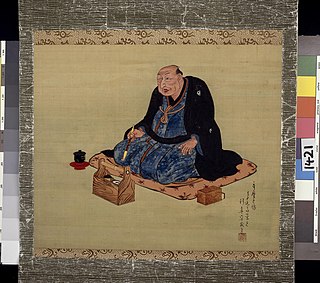
Kitagawa Utamaro was a Japanese artist. He is one of the most highly regarded designers of ukiyo-e woodblock prints and paintings, and is best known for his bijin ōkubi-e "large-headed pictures of beautiful women" of the 1790s. He also produced nature studies, particularly illustrated books of insects.
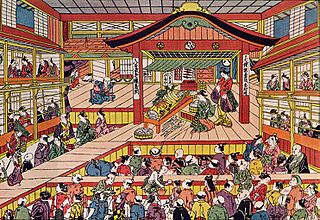
Ukiyo-e is a genre of Japanese art which flourished from the 17th through 19th centuries. Its artists produced woodblock prints and paintings of such subjects as female beauties; kabuki actors and sumo wrestlers; scenes from history and folk tales; travel scenes and landscapes; flora and fauna; and erotica. The term ukiyo-e translates as "picture[s] of the floating world".

Katsushika Hokusai, known simply as Hokusai, was a Japanese artist, ukiyo-e painter and printmaker of the Edo period. Hokusai is best known for the woodblock print series Thirty-Six Views of Mount Fuji which includes the internationally iconic print The Great Wave off Kanagawa.

Utagawa Kuniyoshi was one of the last great masters of the Japanese ukiyo-e style of woodblock prints and painting. He was a member of the Utagawa school.

The Kanō school is one of the most famous schools of Japanese painting. The Kanō school of painting was the dominant style of painting from the late 15th century until the Meiji period which began in 1868, by which time the school had divided into many different branches. The Kanō family itself produced a string of major artists over several generations, to which large numbers of unrelated artists trained in workshops of the school can be added. Some artists married into the family and changed their names, and others were adopted. According to the historian of Japanese art Robert Treat Paine, "another family which in direct blood line produced so many men of genius ... would be hard to find".
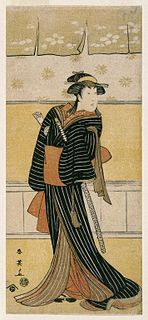
The Katsukawa school was a school of Japanese ukiyo-e art, founded by Miyagawa Shunsui. It specialized in paintings (nikuhitsu-ga) and prints of kabuki actors (yakusha-e), sumo wrestlers, and beautiful women (bijin-ga).
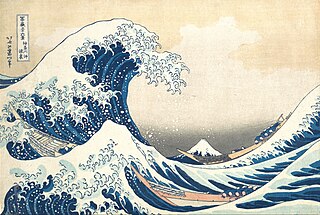
Woodblock printing in Japan is a technique best known for its use in the ukiyo-e artistic genre of single sheets, but it was also used for printing books in the same period. Widely adopted in Japan during the Edo period (1603–1868) and similar to woodcut in Western printmaking in some regards, the mokuhanga technique differs in that it uses water-based inks—as opposed to western woodcut, which typically uses oil-based inks. The Japanese water-based inks provide a wide range of vivid colors, glazes, and transparency.

Utagawa Kunimasu was a designer of ukiyo-e woodblock prints in Osaka who was active during the late Edo period. He was a leading producer of kamigata-e, prints from the Osaka and Kyoto areas. He is also known as Sadamasu [貞升], the artist name he used prior to Kunimasu.
Richard Douglas Lane (1926–2002) was an American scholar, author, collector, and dealer of Japanese art. He lived in Japan for much of his life, and had a long association with the Honolulu Museum of Art in Hawaii, which now holds his vast art collection.

Utagawa Toyoharu was a Japanese artist in the ukiyo-e genre, known as the founder of the Utagawa school and for his uki-e pictures that incorporated Western-style geometrical perspective to create a sense of depth.

The two ukiyo-e woodblock prints making up View of Tempōzan Park in Naniwa are half of a tetraptych by Osaka artist Gochōtei Sadamasu. They depict a scene of crowds visiting Mount Tempō in springtime to admire its natural beauty. The sheets belong to the permanent collection of the Royal Ontario Museum, Canada.
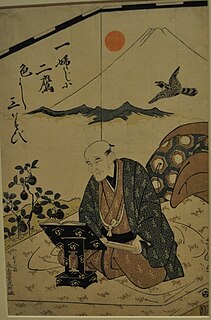
Eijūdō Hibino at Seventy-one is an ukiyo-e woodblock print dating to around 1799 by Edo period artist Utagawa Toyokuni I. According to its inscription, the print was produced in commemoration of the featured subject, print publisher Nishimuraya Yohachi I's, seventy-first year. The print is part of the permanent collection of the Royal Ontario Museum, Toronto, Canada.

Actor Arashi Rikan II as Osome is an ukiyo-e woodblock print by Osaka print artist Ryūsai Shigeharu. It depicts late Edo period kabuki actor, Arashi Rikan II as the lead female character in a scene from a popular play of the period. The print belongs to the permanent collection of the Prince Takamado Gallery of Japanese Art in the Royal Ontario Museum, Canada.

Ryūsai Shigeharu (柳窗重春/柳斎重春) (1802–1853) was an Osaka-based Japanese ukiyo-e woodblock print artist active during the first half of the nineteenth century. A member of the Utagawa school, he was one of a very select group of kamigata-e print artists who were able to support themselves solely as professional artists.

Three Travellers before a Waterfall is an ukiyo-e woodblock print by Osaka-based late Edo period print designer Ryūsai Shigeharu (1802–1853). It depicts a light-hearted scene of two men and one woman travelling on foot through the country-side. The print belongs to the permanent collection of the Prince Takamado Gallery of Japanese Art in the Royal Ontario Museum, Canada.
One Hundred Ghost Stories is a series of ukiyo-e woodblock prints made by Katsushika Hokusai in the Yūrei-zu genre in c. 1830. There are only five prints in this series, though as its title suggests, the publisher, Tsuruya Kiemon, and Hokusai wanted to make a series of one hundred prints. Hokusai was in his seventies when he worked on this series, and though his most famous impressions are of nature, he was aware of the beliefs of the Edo period and depicts ghosts from a well-known stories, many of which were also famous kabuki plays. Each print represents one story, that could be recited during the game of Hyakumonogatari Kaidankai.















